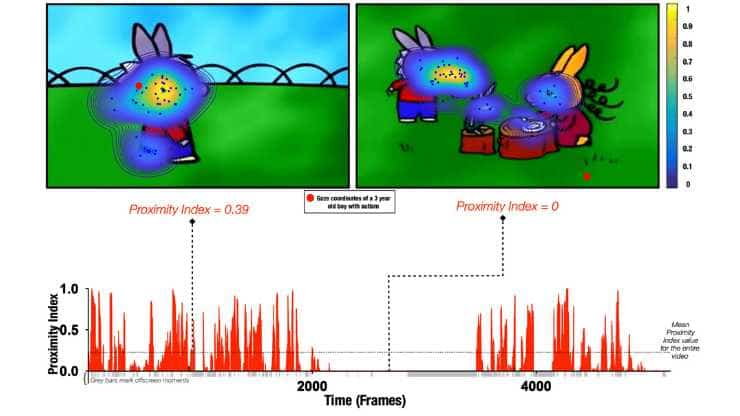As they grow, children’s attention shifts to social factors in their surroundings, such as faces or social interactions. However, children with autism are frequently more engaged in non-social stimuli, such as textures or geometric shapes.
By tracking where children look while viewing a cartoon, researchers at Université de Genève have revealed that attention in autistic children does not follow the same developmental trajectory as that of neurotypically developing children. Instead, each gradually develops their own distinct attentional preferences.
These findings support early interventions aimed at improving social attention, which could help guide autistic children along developmental paths more similar to their peers, paving the way for tailored, individualized support.
Impaired Fascination with Faces
Infants are born with inherent capabilities that are vital for their sustenance and adjustment. One such inherent capability is an intricate attentional system that is precisely calibrated to perceive the presence of others.
Thus, infants exhibit an early fascination with faces and face-like formations, particularly those that are in motion. This early preference for biological movement is crucial for development, serving as the primary motivator for environmental exploration and interaction before laying the foundation for more complex social interactions in the long run.
However, this universally recognized and essential social focus may be compromised in youngsters diagnosed with autism spectrum disorders (ASD). This exceptionally heterogeneous neurodevelopmental disorder is distinguished by repetitive actions and particularized interests, in addition to substantial difficulties in interpersonal social interactions and communication.
Cartoon Eye-tracking
Are these social challenges expressed in the same way in all children with ASD? Do they vary according to the intensity of the disorder and/or age?
The visual preferences of 166 children with autism spectrum disorder and 51 typically developing children (TD) were analyzed by a UNIGE team as they watched a brief cartoon while using an eye-tracking device that records eye movements in real-time. For sample homogeneity, the participants, who were all boys, were evaluated repeatedly as they matured and spanned in age from two to seven years.
“Each child watched a three-minute cartoon featuring a little donkey in various social situations, without any specific instructions. This was not a cartoon specially designed for our study, but rather one that is very popular among children in this age group,”
explained first author Nada Kojovic, a postdoctoral scholar in the Department of Psychiatry at the UNIGE Faculty of Medicine.
Distinct Visual Preferences
It has been observed that typically developing children concentrate on the social interactions among characters, and as they mature, they devote an increasing amount of attention to the specific social elements present in a given scene. ASD children lack this phenomenon of “synchronisation” that is seen in typically developing children.
The latter are interested in other types of stimuli, such as objects or irregularities in cartoon scenery, and each autism spectrum disorder child develops his or her own distinct visual preferences over time.
“It is likely that we could identify sub-groups with common preferences among ASD children, but there is no real synchronisation of attention over the course of their development, unlike what is observed in TD children. This is the first time that a study has highlighted this developmental phenomenon,”
stated Daphné Bavelier, a full professor in the Psychology Section of the UNIGE’s Faculty of Psychology and Educational Sciences, and a co-author of the study.
Predicting Future Social Difficulties
Additionally, the researchers noted that autistic children whose gaze most closely resembled that of typically developing children exhibited enhanced cognitive abilities and improved functionality in daily life. Significantly, the manner in which a child perceives a social scenario, as exemplified by the caricature presented here, can serve as an indicator of forthcoming social challenges.
“These findings show how important it is for therapeutic interventions to target social attention at a very early stage in ASD children, especially those with the greatest developmental delay. Indeed, this work shows that if autistic children do not show interest in social interactions early on, they will become increasingly disinterested in them,”
said Marie Schaer, associate professor in the Department of Psychiatry at the UNIGE Faculty of Medicine, who led this research.
Subsequently, the UNIGE research team intends to assess children who have benefited from the Early Start Denver Model (ESDM) behavioral intervention by employing its eye-tracking procedure. Developed in the United States, this intensive behavioral intervention aims to improve the communication abilities of young autistic children via playful interactions.
More than one hundred autistic infants below the age of three have experienced positive results with this approach in Geneva since 2012. The researchers aim to utilize their novel eye-tracking technique to illuminate the manner in which this behavioral intervention aids in the advancement of children with autism spectrum disorder, thereby furnishing a distinct instrument to enhance approaches that foster their growth.
Reference:
- Nada Kojovic, Sezen Cekic, Santiago Herce Castañón, Martina Franchini, Holger Franz Sperdin, Corrado Sandini, Reem Kais Jan, Daniela Zöller, Lylia Ben Hadid, Daphné Bavelier, Marie Schaer. Unraveling the developmental dynamic of visual exploration of social interactions in autism. eLife, 2024; 13 DOI: 10.7554/eLife.85623
Image: Proximity Index method illustration. Upper row: two example frames with gaze coordinates of TD children (blue dots) used to define the “reference” (delimited by contours) and gaze data from a three-year-old male with ASD (whose gaze coordinates are depicted as a red circle). Hotter contour color indicates the area of higher density of distribution of gaze in the TD group.
Lower row: Proximity Index values for the visual exploration of the three-year-old boy with ASD over the entire video with mean Proximity Index value indicated by the dashed red lines. Credit: eLife, 2024; 13 DOI: 10.7554/eLife.85623
